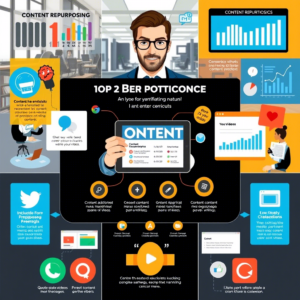In today’s fast-paced digital world, capturing and retaining your audience’s attention is more challenging than ever. With so much content being produced daily, standing out has become a necessity for bloggers and marketers alike.
One powerful tool that can significantly enhance blog post performance is visual content. But why does it matter? And how can you leverage it effectively?
In this article, we’ll explore the importance of visuals, practical ways to use them, and their impact on engagement and conversion rates.
Why Visuals Matter in Blogging
Humans are naturally drawn to images. Studies show that posts with visuals receive 94% more views compared to those without.
This isn’t surprising when you consider how our brains process information—visuals are processed 60,000 times faster than text. By incorporating high-quality visuals into your blog posts, you make your content more engaging and memorable.
For instance, imagine reading a lengthy article about healthy eating habits. Without any supporting graphics, charts, or photos, it might feel overwhelming or dull.
However, adding an infographic summarizing key points or a mouthwatering picture of a nutritious meal makes the content instantly more appealing. Visuals simplify complex ideas and help readers grasp concepts quickly, making your message resonate deeper.
How Visuals Boost Engagement
Engagement is crucial for any successful blog. When done right, visuals encourage readers to spend more time on your page, interact with your content, and even share it with others. Here’s how:
Increased Time Spent on Page : Compelling visuals break up large blocks of text, creating a visually pleasing layout that invites exploration.
Higher Social Shares : Posts with eye-catching images are shared up to 150% more often on social media platforms like Facebook and Instagram.
Improved Retention Rates : Research shows people remember 65% of visual information after three days, compared to just 10% of written content.
To maximize these benefits, ensure your visuals align with your brand identity and complement your writing style. For example, if you run a travel blog, vibrant landscape photographs will captivate your audience far better than generic stock photos.
Practical Tips for Using Visuals Effectively
Implementing visual content doesn’t have to be complicated. Even beginners can create stunning visuals using free tools like Canva or Unsplash. Below are some actionable tips:
Use Consistent Branding : Stick to a color palette and font styles that reflect your brand’s personality.
Optimize Image Sizes : Large files slow down loading times, which negatively impacts user experience. Compress images while maintaining quality.
Add Alt Text : Not only does this improve accessibility for visually impaired users, but it also boosts SEO by helping search engines understand what your images depict.
Additionally, don’t shy away from experimenting with different formats such as GIFs, videos, or interactive elements. These dynamic options keep visitors entertained and engaged longer.
Visual Storytelling: A Powerful Strategy
Storytelling through visuals adds depth and emotion to your blog posts. Instead of merely listing facts or figures, tell a story that connects with your audience emotionally.
For example, instead of saying “Our company helps reduce carbon emissions,” show a before-and-after image of polluted versus clean environments. The contrast creates a stronger emotional response, driving home your point effectively.
Moreover, storytelling fosters trust between you and your readers. If you’re sharing personal experiences or case studies, pairing them with relevant visuals strengthens credibility and authenticity. Remember, every picture tells a thousand words—but only if used thoughtfully.
Measuring Success and Continuous Improvement
Once you’ve integrated visual content into your blog strategy, tracking its effectiveness becomes essential. Key metrics to monitor include:
- Bounce rate: Does adding visuals reduce the likelihood of users leaving immediately?
- Average session duration: Are visitors staying longer due to engaging visuals?
- Conversion rates: Do calls-to-action paired with compelling visuals lead to higher click-throughs?
Tools like Google Analytics provide valuable insights into these areas. Based on your findings, refine your approach. Perhaps certain types of visuals perform better for specific topics or audiences. Stay adaptable and open to learning.
Conclusion
Visual content plays a pivotal role in enhancing blog post performance by increasing engagement, improving retention, and fostering emotional connections with your audience.
Whether you’re a seasoned blogger or just starting out, investing time in crafting meaningful visuals pays dividends. From simplifying complex information to telling captivating stories, visuals elevate your content game.
So, here’s your call to action: Take a closer look at your current blog posts. Could they benefit from more strategic use of visuals? Experiment with new formats, gather feedback, and watch your results soar. And remember, great content isn’t just about what you write—it’s also about what you show.
We’d love to hear from you! What type of visual content do you find most effective in blogs? Share your thoughts in the comments below.




